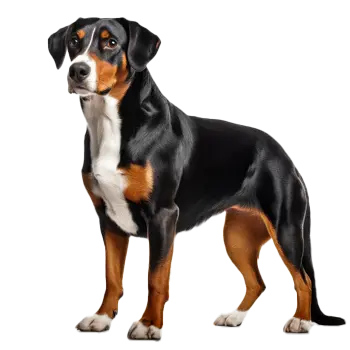The Appenzell Mountain Dog presents a well-balanced, medium-sized silhouette that reflects its heritage as an agile mountain herding dog. The overall appearance conveys strength without heaviness, with slightly more length than height in body proportion. Males typically stand 20 to 23 inches at the shoulder, while females measure 19 to 21 inches. Weight ranges from 48 to 70 pounds, with males generally at the heavier end of the spectrum. The breed should appear muscular and athletic, capable of working in challenging Alpine terrain for extended periods.
The head is proportionate to the body with a fairly flat skull that is broadest between the ears. A slight furrow runs from the stop to the occiput, and the stop itself is clearly defined but not overly pronounced. The eyes are small to medium in size, almond-shaped, and dark brown in color, conveying an alert and lively expression characteristic of the breed. Eye rims are fully pigmented. The ears are set high and wide, triangular in shape with slightly rounded tips, and hang flat against the cheeks when at rest but lift at the base when the dog is attentive.
The muzzle tapers slightly from the stop to the nose but is never pointed or snipey. The bridge of the nose is straight, and the length of the muzzle relates to the skull in approximately a 4:5 ratio. The nose is fully black regardless of coat color. Lips are tight and well-pigmented, forming a clean profile without excessive flews. The jaw is strong with a complete scissor bite, and cheek muscles are well-developed but not prominent. The neck is strong and muscular, of medium length, blending smoothly into well-laid-back shoulders.
The body structure demonstrates the breed's working heritage. The topline is level and firm from withers to croup. The chest is broad and deep, reaching to the elbows, with well-sprung ribs that provide adequate lung capacity for endurance work. The underline shows moderate tuck-up. The back is straight and strong, the loin is short and muscular, and the croup is slightly sloped. The tail is set high and carried in a tight curl over the back when the dog is alert or moving, which is one of the breed's most distinctive features.
Front legs are straight when viewed from any angle, with strong bone proportionate to body size. Shoulders are long and sloping, providing good reach in movement. Elbows are held close to the body. Pasterns are short, strong, and slightly sloping. Feet are compact and round with well-arched toes and thick pads. Dewclaws may be removed. The hindquarters show strong muscling with good angulation. Upper and lower thighs are well-developed, hocks are perpendicular to the ground, and rear feet match the front in construction.
The coat is a dense double coat providing protection against harsh mountain weather. The outer coat is short to medium in length, lying close to the body with a healthy sheen. Texture is harsh and straight or only slightly wavy. The undercoat is thick, particularly in winter months. Coat is slightly longer and forms a slight mane around the neck and chest. Feathering appears on the backs of the thighs and underside of the tail. The face, ears, and fronts of the legs have short, smooth coat.
The Appenzell Mountain Dog is always tricolored. The base color is either jet black or dark brown (havana). Symmetrical rust markings appear above the eyes, on the cheeks, chest, legs, and under the tail. White markings include a blaze extending from the top of the head down between the eyes to the muzzle, a white chest marking in an inverted cross or V-shape, white feet, and white tail tip. Rust always appears between the black or brown base color and white markings, creating the distinctive tricolor pattern. Asymmetrical markings are considered faults, and excessive white or absence of required markings is undesirable.
Movement is purposeful and efficient with good reach and drive. The gait should be fluid and ground-covering at the trot, with legs moving in parallel planes without crossing or interference. The topline remains level and firm during movement. At faster speeds, legs converge toward a center line. The overall impression is one of tireless, effortless motion suitable for covering rough mountain terrain while working livestock.
Sexual dimorphism is apparent, with males displaying more masculine features including larger heads and more substantial bone structure, while females appear more refined but should not lack substance. Both sexes should present an alert, confident bearing with natural working instincts evident in their demeanor.
Affection Level
★
★
★
★
★
Devoted and affectionate with family members, though may be reserved with strangers
Good with Children
Excellent with children when properly socialized; natural protective instincts make them gentle guardians
Good with Other Dogs
★
★
★
★
★
Generally good with other dogs when socialized early; may show dominance with same-sex dogs
Good with Other Pets
Good with household pets when raised together; herding instinct may lead to chasing smaller animals
Playfulness
Highly playful and energetic; enjoys interactive games and activities with family
Energy Level
Very high energy requiring substantial daily exercise and mental stimulation
Trainability
Highly trainable and eager to work; responds well to positive reinforcement methods
Intelligence
Exceptionally intelligent problem-solver; learns quickly and retains training well
Tendency to Bark
Moderate to high; alert barker who will announce visitors and unusual activities
Amount of Shedding
Moderate shedding year-round with heavier seasonal shedding periods
Grooming Needs
Moderate; weekly brushing needed, more frequent during shedding seasons
Prey Drive
Moderate prey drive; herding instinct may manifest as chasing moving objects

